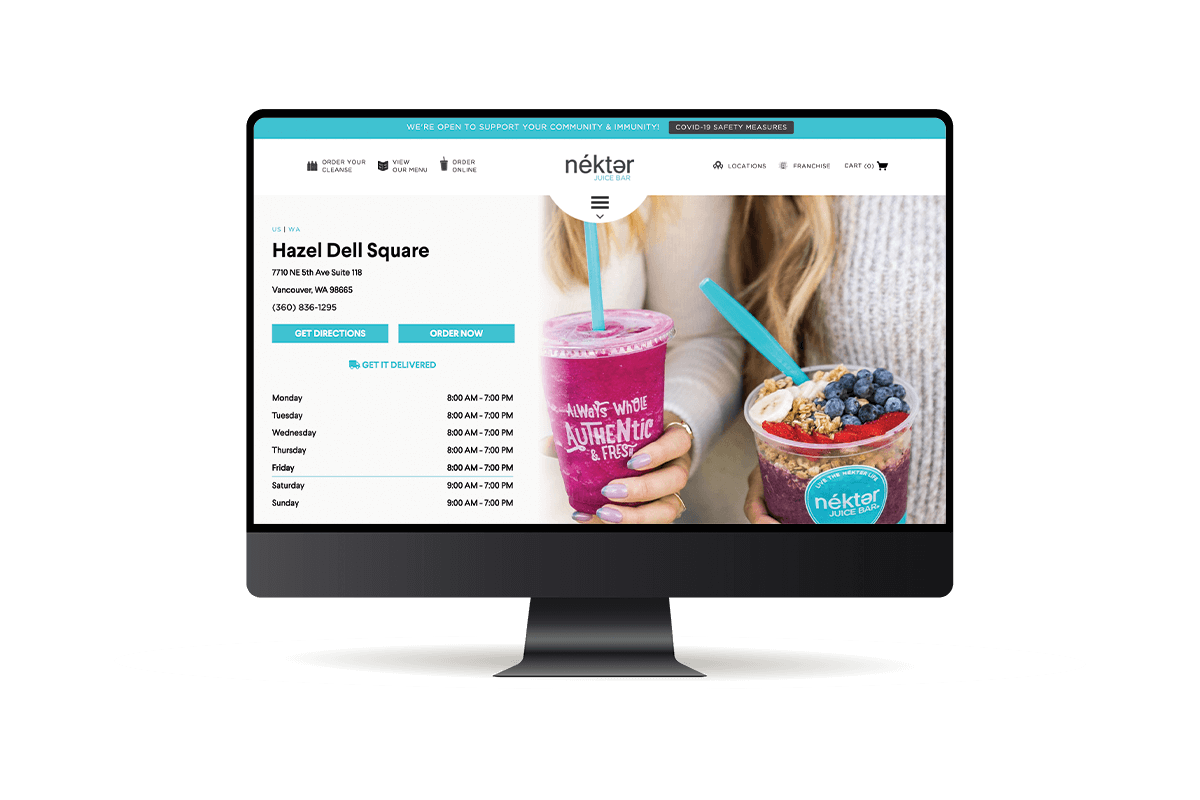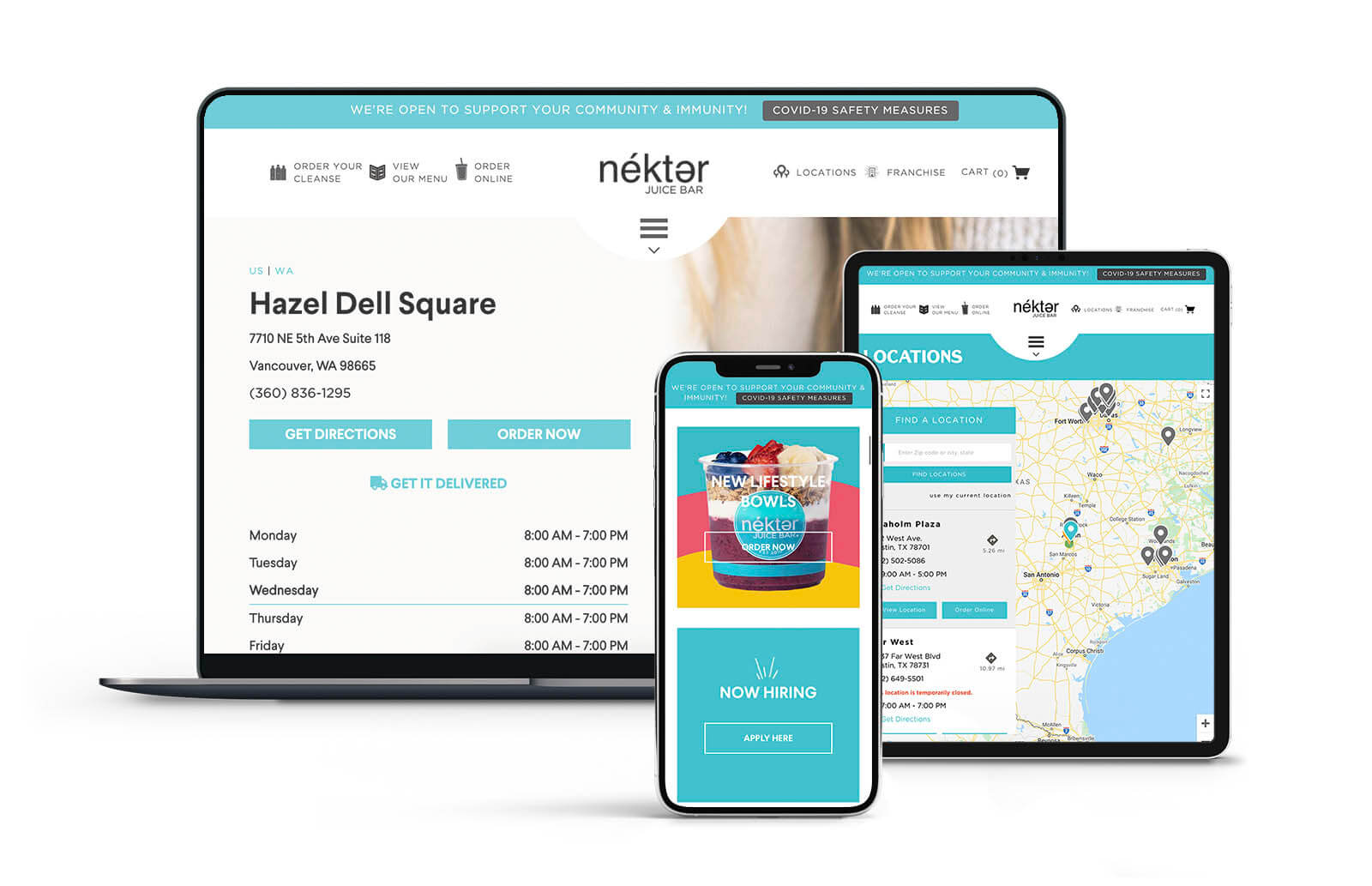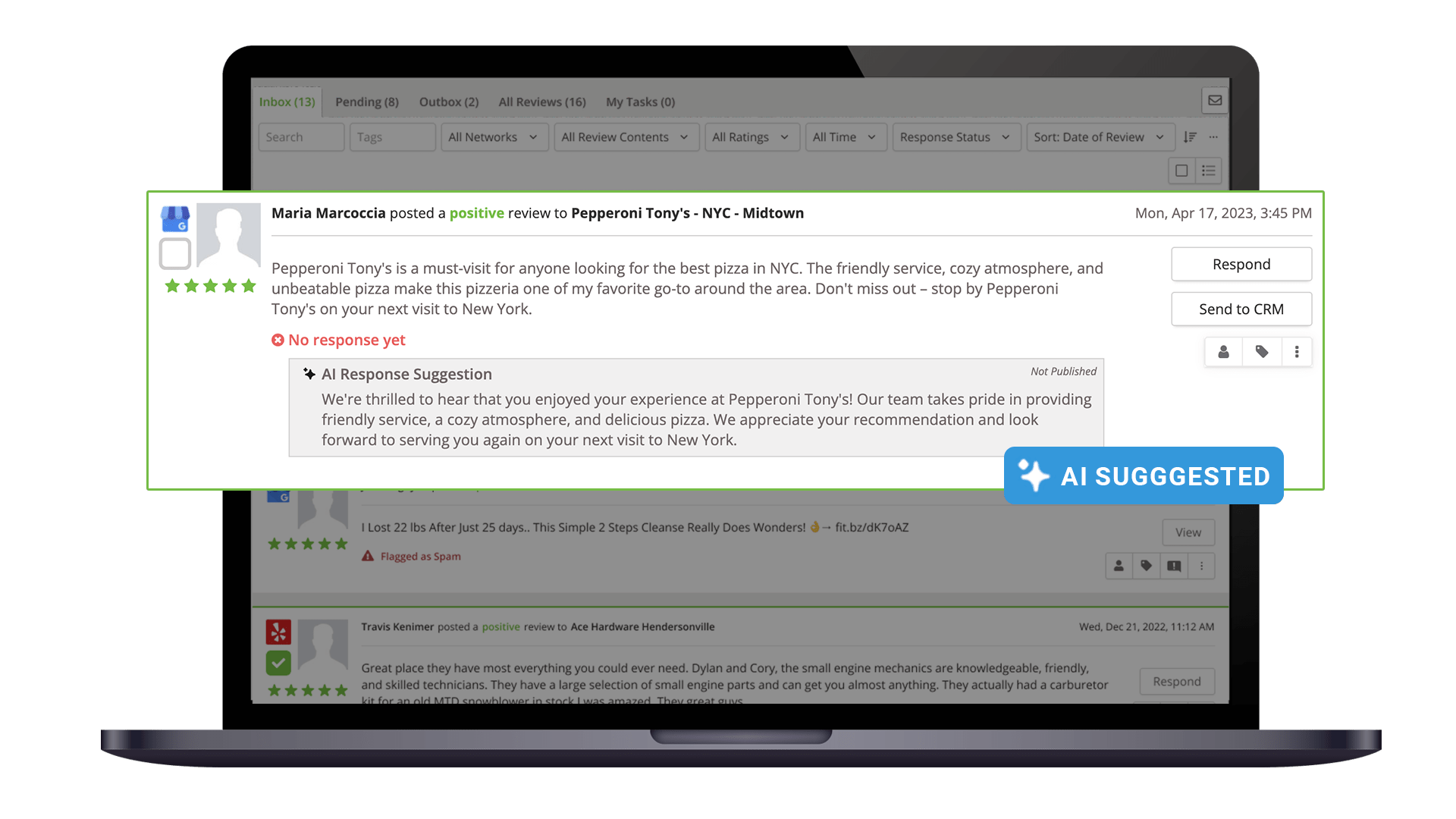The Complete Guide to Franchise Marketing
Table of Contents
Franchise marketing requires a delicate balance between national visibility and local engagement. It’s an intricate harmony where the franchisor’s vision synchronizes with the franchisee’s unique local flavor.
At SOCi, we’ve helped over 800 multi-location brands and over three million locations — many of which use the franchise business model — create and run a successful multi-location marketing system.
In this blog, we break down the core concepts of franchise marketing and outline the essential tactics to set your franchise on the path to success.
Ready to enhance your franchise marketing strategy? Let’s dive in!
Franchise, Franchisor, and Franchisee: What’s the Difference?
Before we go any further, we need to ensure we have matching definitions of a franchise, franchisor, and franchisee.
Franchise:
A business model where the owner (franchisor) grants an individual or entity (franchisee) the right to operate a business using its established brand, products, and processes.
Franchisor:
The entity or company that owns the brand, trademarks, and business model. The franchisor grants individual operators (franchisees) the right to operate under its brand.
Franchisee:
An individual or entity that buys the right to operate a business using the franchisor’s brand, products, and processes.
Read our article for more details on how these three entities operate together.
What is Franchise Marketing?
In the simplest terms, franchise marketing is any act a franchise does to grow the business.
More specifically, franchise marketing is divided into two segments: franchise development marketing and operational franchise marketing.
Franchise development marketing:
The franchisor performs development marketing to sell more franchise locations and increase the number of franchisees.
Operational franchise marketing:
Operational franchise marketing is when franchisors and franchisees use specific marketing tactics in unison to build brand awareness, acquire new customers, and increase revenue at the local and national levels.
In this blog post, we‘ll focus on operational franchise marketing.
Typically, the franchisor has already built a solid and reputable brand. To uphold this brand, you need a thriving franchise marketing strategy where franchisors and franchisees work cohesively to create and deploy local and national marketing campaigns.
Doing so strengthens the brand and results in more profits across the board.
12 Essential Franchise Marketing Tactics
Below are 12 franchise marketing tactics your franchise business can implement today to increase your online presence and profit!
1. Install Brand Guidelines and Standardization
An essential part of franchise marketing is customer experience marketing, which requires consistent branding. When a consumer visits a franchisee, they expect to receive the same excellent service as any other location.
Brand Guidelines
These expectations also hold true when consumers see your franchise’s digital marketing campaigns. Thus, it’s imperative that a franchisor establishes clear brand guidelines and shares them with all franchisees.
These brand guidelines often include the following:
- The franchise’s history
- Mission and vision statements
- Core values
- Brand colors, fonts, and logos
- Voice and tone guidelines and examples
- Customer service and operational instructions
Accessing Branded Material
Franchisees should be able to access these guidelines and any associated content easily. Many franchises have a digital asset management (DAM) system or a library that houses brand guidelines and content marketing material, such as associated images and videos.
Training Franchisees on Brand Guidelines
Standardization diminishes if individual franchisees don’t adhere to these brand guidelines. Thus, you must train franchisees on these brand guidelines and how to implement them correctly. This training helps to ensure franchisees uphold these brand guidelines in their online marketing campaigns.
Utilize Artificial Intelligence
Franchise companies can leverage AI to closely monitor adherence to brand guidelines through automated systems that analyze marketing content. Utilizing AI helps assure consistency across franchisees, fostering a unified brand identity and upholding the standards for sustained success.
2. Claim and Optimize Local Listings
Many franchisors worry about their national brand, which is a good thing. However, they should also focus on local SEO (search engine optimization) and attracting local users. Done correctly, local SEO often increases local businesses’ and franchisees’ visibility in local search results on Google and other search engines.
Improving your local listings and local pages is the best way to improve your local SEO rankings. We’ll dive into local listings first.
Local listings are local business profiles on local directories like Google, Bing, and Yelp. Franchisees often have local listings across multiple directories, although a presence on Google is most important, with the tech giant having over 83% of the search engine market share.
From a local SEO and user experience, your franchisees’ local listings must contain accurate information. Here’s a step-by-step process for optimizing your local listings:
Step one: Claim your local listings across all directories, especially on Google
Step two: Ensure each franchise doesn’t have duplicate listings, and report duplicate listings not owned by your franchise.
Step three: Include helpful business information such as the name, address, and phone number (NAP), business hours, and contact information. Also, ensure that each listing has the same information across all directories.
For a more in-depth guide to claiming and adjusting your local listings, read our blog on optimizing your local listings.
3. Create Local Pages and Franchisee Locators
Local pages, also called local landing pages, are another way to improve local search visibility and drive more business to your franchisees. A local page is a specific web page on your website for each franchisee. It typically highlights the franchisees’ products and services.
Like local listings, local pages should include any relevant business information a consumer might need, such as your NAP, hours of operation, directions, a list of products or services, or calls to action (CTAs), such as an option for online ordering.
You can further optimize your local landing pages by doing the following:
- Incorporate keywords on your local pages
- Include high-quality images
- Add alt text or tags to images
- Create clean URL structures
- Ensure the meta description is enticing and contains relevant keywords
- Have multiple calls to action (CTAs) to increase lead conversion
- Highlight user-generated content (UGC) such as reviews or customer testimonials
Read our blog post on local landing pages, for an in-depth guide to creating and optimizing your local pages.
In addition to local landing pages, franchises need store locators. In this case, a franchisee locator is a unique page on your website that lists all franchisee locations and links to their local pages. Think of it as your website’s online directory.
They often display valuable information about each franchisee, such as:
- An interactive map showing franchisee locations
- Location and directions
- Hours of operation
- Special promotions or events.
Locators and local pages make it easier for consumers to locate and visit your franchisees, which helps convert online visitors into in-person customers. They also help with organic search rankings.
4. Produce Local Content on Social Media
Social media allows franchises to generate nationwide and local content that can reach millions of consumers.
According to one survey, three in four consumers have discovered a new local offering based on social media recommendations and posts. Furthermore, previous research from SOCi found that localized content receives 12 times the engagement rate of more general or non-localized content.
Franchisees need to post relevant local content that consumers can engage with. This content can include local community events, news, promotions, and partnerships.
To make things easier, local franchisee teams should utilize the national digital asset management (DAM) system to publish branded graphics and content.
For a full rundown of what type of localized content to publish, download our Localized Social Content Guide for Multi-Location Marketers.
5. Establish an Advertising Strategy and Budget
Another vital aspect of social media marketing is social advertising. Social advertising, or social media advertising, is when a franchisor puts money behind social media campaigns to increase brand awareness, engagement, or lead generation. Franchisors should create local or national social ad campaigns depending on their goals.
National Social Ads:
Typically, national social ads help with brand awareness or promote new products or services. These ads often influence local consumers to visit your franchisees.
Local Social Ads:
Local social ads usually generate leads and help acquire more online foot traffic and in-store visitors. Franchisees can promote community-based and local stories that gain traction and strengthen brand loyalty.
With social media ads, you also need to consider budgets. Franchisors must establish monthly and quarterly budgets regardless of who produces the paid social ads.
You must adjust these budgets based on social ads’ performances — allocating more money behind a successful campaign or duplicating high-ROI ads across multiple franchisees.
6. Interact with Customers on Social Media
More than three-quarters of consumers expect companies to respond to their comments on social media. Timeliness also matters. Eighty-three percent of consumers expect companies to respond within a day or less.
As you can see, responding and engaging with customers across your social media channels is a necessary component of franchise marketing. You can have local, corporate, or a mixture of the two teams respond to these social media interactions.
Or, better yet, use generative AI to draft on-brand responses that teams can quickly review and then publish. Remember, poorly worded responses could lead to unfavorable comments and further disrupt your customer experience and brand image, so human oversight is needed.
7. Monitor and Respond to Online Reviews
A franchisor must monitor its brand’s online reputation at national and local levels. An individual franchisee’s reputation can affect the entire brand.
An essential aspect of online reputation management (ORM) is monitoring and responding to reviews across all your franchisees. These reviews can occur on review sites like Yelp, Google, and social media platforms.
Local or national teams can respond to online reviews, similar to how your franchise interacts with social media engagements.
Regardless of who responds to reviews, ensure that they’re well-trained and that you have consistent responses across all franchisees. Again, we recommend utilizing generative AI software to create branded and specific responses to reviews. This will help save your team time and effort while boosting efficiency.
You can download The Multi-Location Marketer’s Guide to Online Reputation Management to upgrade your franchisees’ reputation.
8. Gain Insight from Other Franchisees’ Reputations
Being a multi-location business allows your franchise to gain insights from all franchisees. For instance, if one franchisee continues to receive stellar reviews, you can analyze those reviews and meet with the franchisee owner and employees to learn about what’s leading to these positive reviews.
You can then take this insight and implement new policies and operations for franchisees struggling with a poor online reputation. You can also learn from low-performing franchisees to ensure their issues don’t occur at other locations.
9. Secure a Competitive Advantage with Social Listening
Franchise marketers can also improve their ORM with social listening technology. Social listening is the process of analyzing conversations and trends around your franchise, brand, competitors, and your industry.
Social listening gives you a 10,000-foot view of your brand’s online reputation and helps you monitor conversations on social media, forums, and other corners of the web. With the right social listening software, you can also listen to and monitor competitors to understand better how your products or services compare to theirs.
Data and insight from these online conversations can lead to:
- A deeper understanding of customer sentiments and preferences
- Changes in your customer experience or journey
- Updates to your products or services
- More tailored franchise marketing content and campaigns
10. Utilize Email Marketing
Franchisees should harness email marketing as a powerful tool to foster customer engagement, build brand loyalty, and drive sales. According to one survey, 79% of marketers put email marketing in their top three most effective channels.
You can send targeted and personalized messages to promote exclusive offers and tailor them to local audiences and regions. To get the most out of your franchise email marketing campaigns, we recommend including:
Analytics and Tracking:
Your email marketing software should have tracking capabilities, allowing you to see open rates, click-through rates, and other engagements that’ll help you refine future campaigns.
Clear Calls to Action (CTAs):
Use compelling CTAs to guide recipients toward desired actions, whether purchasing, visiting the store, or engaging with promotional content.
A/B Testing:
A/B testing in email marketing involves sending two versions of an email to different audience segments with slight variations, such as subject lines or content, to determine which version performs better regarding open rates, click-through rates, and other metrics.
A/B testing helps to improve engagement rates and conversions in future campaigns.
Mobile Optimization:
Design emails to be mobile-friendly, as many users access emails on smartphones, ensuring a seamless experience across devices.
11. Continue to Incorporate Direct Mail
According to a United States Postal Service (USPS) research report, when receiving mail, consumers took the following actions:
- Forty-two percent went to a company’s website.
- Twenty-eight percent went to a company’s physical location to shop.
- Nearly one in five made a purchase after receiving a reminder in the mail.
When sending direct mail, we recommend including coupons or deals. According to the same USPS report, 72% of Generation Z and 89% of baby boomers prefer direct mail that includes a deal.
Additionally, nearly half of Gen Z and over a third of baby boomers prefer mail from a locally owned business. Thus, your direct mail should come from local franchisees. To make the mail more localized, include a QR code to the franchisee’s landing page, their address, and a photo or quote from the owner.
12. Partner With a Software Company Built for Franchise Companies
You now have the information needed to take your franchise marketing to the next level. However, manually doing these numerous franchise marketing tasks presents quite a challenge. To automate your franchise marketing, look no further than SOCi.
SOCi has various software and resources to help you improve your franchise marketing at the national and local levels.
SOCi Listings and SOCi Pages can take your local SEO to the next level. Meanwhile, SOCi Social will help you schedule, manage, and advertise on all major social media platforms.
In addition, SOCi Reviews and SOCi Surveys can help you track and respond to reviews on all major review sites and gain critical insight into customers’ and competitors’ conversations.
We’re also overlaying our products with SOCi Genius, our AI-based layer that automatically aggregates data and produces on-brand responses or content.
We’ve already woven Genius into our reputation management software and plan to launch our Genius Social (Content and Engagements) in January 2024.
Request a demo today to learn more about these products or SOCi’s services!





